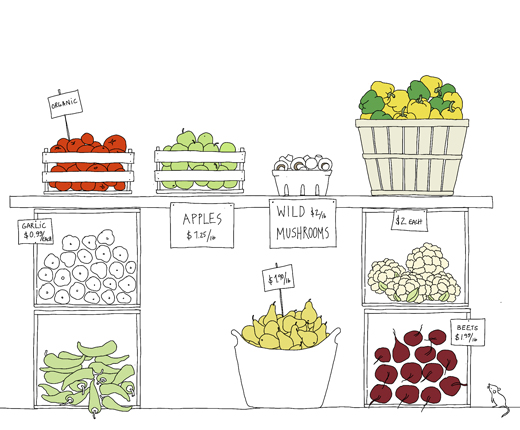
Recently I illustrated the article Market Fresh by Jules Clancy. The article is about shopping local fresh vegetable from the market. It was published in the summer issue of Foodie Crush Magazine created by Heidi Larsen, July 2012.

Recently I illustrated the article Market Fresh by Jules Clancy. The article is about shopping local fresh vegetable from the market. It was published in the summer issue of Foodie Crush Magazine created by Heidi Larsen, July 2012.

One small reason I draw my food is that my cooking results will probably never look as good as Stephane Lemagnen’s creations. It’s silly of me to compare (and I’m not really trying), as Stephane happens to be a well trained chef. On his site Zen Can Cook he shows mouth watering examples of his ability. If you visit the site you’ll also notice that his photography skills aren’t bad either. His cooking and recipes are creative and a great inspiration for many other cooks all over the world. Even if his creations look complicated most of the recipes are easy to follow and can be cooked in a regularly equipped kitchen like mine. My aquavit pork buns were created based on Stephane’s way to cure pork belly.
Stephane grew up in Gascony, France and trained as a cook in the Pays Basque and Paris. In 2006 he opened the avant-garde dessert bar, Room 4 Dessert here in New York City where he offered modern cuisine in the form of a dessert tasting menu. Today, Stephane works as a full time private chef for a well known (secret) client. Lucky them! Recently Stephane started Zenspotting, a space for chefs and serious amateur cooks to publish their photos with links to interesting recipes. I’m flattered to be part of it.
Stephane and I met through twitter two years ago. Ever since then we have had great and inspiring exchanges by email or tweets. I’m happy to host Stephane and I’m really happy how this simple cheese ravioli turned out. Enjoy.

Four-Cheese Ravioli with Tomato Sauce
by Stephane Lemagnen
I’m thrilled to see one of my recipes come to life through Johanna’s illustrations. I have admired her work for a numbers of years now and always loved her recipes and her artistic way of explaining how things are done. And it’s even better with a glass of aquavit! Kokblog is clever, delicious and visually pleasing and it made me wish I stuck with those art classes in 5th grade.
Ravioli are also clever and delicious little morsels of happiness, and for me they are at their best when left simple. An oozy, cheesy filling in a soft envelop of pasta with a tomato sauce flavored with hints of fresh basil is often all you need to put a smile on people’s face. And it’s as easy as… the illustrations. Drawing, in fact, is much harder than ravioli-making and eating them is definitely easier than both. They can be enjoyed right away, or made in batches and frozen for future use which makes them great little discoveries to be made in your freezer.
for the pasta dough
3 cups all-purpose or “00″ flour, plus more for dusting work surface
1/2 teaspoon salt
4 whole eggs
4 yolks
2 tablespoons olive oil
for the cheese filling
8 ounces ricotta (drained)
4 ounces Montasio cheese (grated)
4 ounces Gorgonzola (crumbled)
4 ounces Italian Fontina cheese (grated)
1 egg
½ cup basil leaves, chopped
salt and pepper
nutmeg
to finish
Tomato sauce
Basil
for the pasta dough
Combine the flour, the salt, the eggs, yolks and olive oil in a Kitchenaid bowl and combine on low speed using the dough hook (this also could be done by hand in a large bowl). Increase the speed until you get a rough dough. This should take 1 or 2 minutes.
When the mixture comes together transfer to a floured clean surface and knead the dough, turning the inside-out, until you obtain a dough that’s smooth on the outside, adding flour every time the dough starts to feel sticky. The whole process should take less than 5 minutes. Wrap the dough in plastic wrap and let it rest in the refrigerator for at least 2 hours, or overnight.
Take the dough out from the fridge and place it on a floured surface. Cut it in 4 equal pieces. With a rolling pin make rectangle with the pieces of dough, so that they fit inside the pasta machine. Start rolling pasta sheets on the thickest setting and cut in half (so it doesn’t get too long). Keep rolling reducing the setting every time.
You should be able to see your hand through the pasta sheets when you have reached the right thickness. You want it thin but not so thin that it becomes fragile.
Make an egg wash by beating an egg with a tablespoon of water. Cut sheets of pasta so they have about the same length and lay them on a floured surface.
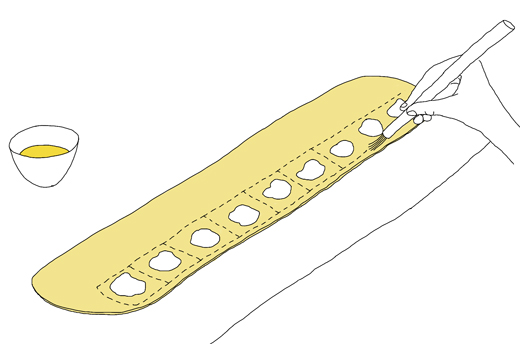
Pipe little mounds of stuffing on the pasta sheets. Brush the edges and the middle sections with egg wash. Cover with another sheet of pasta. Seal with your fingers and push out any air pockets. Use the back of a pastry cutter the size of the mounds to seal each ravioli. Now use a pasta cutter or pastry cutter to portion the raviolis. Reserve on a single layer on a tray dusted with semolina flour.
for the filling
Combine all the ingredients by hand, or in a food processor. Season to taste. Place in a pastry bag with a round 1/2 inch tip.
to finish
Bring a pot of salted water to a boil. Drop the ravioli in the water and cook until they come back to the surface. About 5 minutes. Drain them and toss with tomato sauce. Garnish with basil.
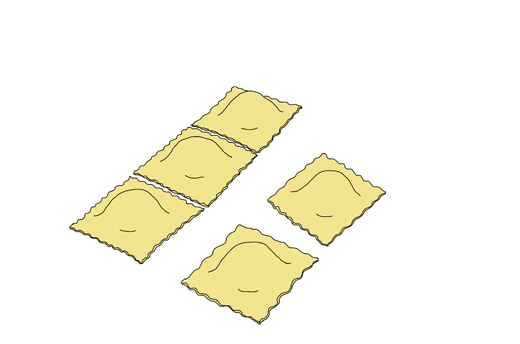
for the tomato sauce
3 tablespoons olive oil
1 small onion, finely chopped
1 clove garlic, finely chopped
1 28 oz. can San Marzano whole peeled tomatoes, including the juice, (or in season 1 3/4 pound of fresh tomatoes, peeled, seeded, and chopped)
2 tablespoons tomato paste
1 large pinch of sugar
1 pinch hot pepper flakes
fresh basil leaves
Heat the olive oil in a saucepan. Add the chopped onion and stir to coat. Reduce the heat to low and let it cook for 15 to 20 minutes, stirring occasionally until soft and translucent. Meanwhile, place the tomatoes in a bowl and crush them with your hands or using a potato masher. Add the garlic to the cooked onions and cook for a minute more. Add the tomatoes, including the juice, a few leaves of basil, the tomato paste and pinch of sugar. Season with salt and pepper and bring to a very low simmer. Cook for 15 to 20 minutes more, stirring occasionally, until it gets thicker. Remove from the heat, if you want you can blend the sauce for a few seconds for a smooth consistency.
…
Here are some other Ravioli recipes by Stephane:
Veal Ravioli with Culatello, Radiccio, Chanterelles & Sage
Langoustine Ravioli with Citrus-Coconut Sauce, Thai “Bird’s Eye” Chili & Fava Beans
Five-Herb Ravioli with Chanterelles, Roasted Tomato Coulis and Basil Oil
More ravioli reads on Kokblog, Duck Egg Raviolo
Pasta Shaping Work Shop on kokblog

Some may think it’s silly to grow your own sorrel when you have it growing wild just around the corner. As the cultivated sorrel has a slightly milder and nicer flavor I believe its a great idea to include this sour and lemony herb in a garden plot.
Its best is to harvest the young light green leaves, as when the leaves gets older and larger (darker green) they get tough and unpleasantly sour. Sorrel can be cooked like spinach for soups and omelets or raw in salads and pesto (see below). I also think the sourness in this pesto works terrifically well with fish, poached or cured. Spread on cracker this sorrel pesto can be a simple and delicious appetizer.
Sorrel Pesto
about 2 cups of young sorrel leaves
2 garlic cloves
a handful of walnuts
fresh red chili to your own taste (I use about ½”- 1″ depending on hotness)
½ cup grated parmesan
olive oil
a few sprigs of parsley (optional)
season with: salt and pepper
Pick about 2 cups of very young Cultivated Sorrel leaves. Rinse the leaves in cold water and drain while you prepare the other ingredients. Chop the walnuts and the chili a little. Grate the Parmesan roughly.
When the sorrel is dry, run them in the food processor (or use a mortar and pestle). Add chopped garlic and run the machine a bit before adding chili, walnuts, (parsley) and parmesan. Drizzle some olive oil over. Blend the mixture carefully as it should have a crunchy texture. If necessary add some more olive oil. Season with salt and fresh pepper.
Note: Sorrel contains plenty of vitamins but the plant contains some oxalic acid which is not healthy if eaten too much (especially if your body easily creates kidney stones). I think to have sorrel on a few occasions over the summer can hardly harm you.

This spring I have seeded plenty of basil and they are now all growing on my window sill. They are doing well but are still too small to be harvested. If you don’t have the patience to seed basil you can of course buy a plant from the plant shop. You can also sometimes find small pots at the vegetable shop which work really well replanted in a larger and nicer pot. I use basil to spice up almost any vinaigrette and as a main herb when making hazelnut baked cauliflower. Why not try basil as a flavor in cocktails! I like it with cucumber in my favorite summer drink pimm’s cup. Even if it’s well known, I still think basil on fresh tomatoes and mozzarella is magical.
This basil pesto is made with the addition of celery stems (and leaves) that gives a nice grassy flavor. Instead of pine nuts I use walnuts (or roasted sunflower seeds). I use this basil pesto with spaghetti, as side to vegetable patties or on bread topped with tomatoes.
Basil & Celery Pesto
2 stems of celery
about 2 cups basil leaves
two cloves of garlic
handful walnuts (or sunflower seeds)
½ cup fresh grated parmesan
olive oil
salt and pepper
Rinse the basil leaves carefully under cold water. Set aside and let dry while preparing the other ingredients. Chop the celery and garlic into small pieces. If the celery comes with leaves I would add them to the pesto as well. Mix all ingredients in a blender, starting with the basil, garlic and some olive oil. Add the celery, walnuts and lastly the grated cheese. Season with salt and pepper. Add as much olive oil as you like. Use less if you like to spread the pesto on bread and more if serving with pasta.
…
Both of these pesto variations, when packed nicely in a jar, are a great summer present – especially when you have a place in your garden where sorrel or basil grows better than any flowers.
If you like to learn more about sorrel I suggest reading Sarah Smith’s article about sorrel at The Foodie Bugle and Clotilde Dusoulier’s 50 Things To Do With Fresh Sorrel post.
Over at Food52 you can follow Amy Penningtons City Dirt column on how to grow plants from seeds etc.
…
this article was originally published at Ecosalon

Every summer I enjoy fresh mint from my own little garden. I grow three quite common types: pepper, lemon and water mint. All three work really well for cooking and I use them regularly in teas or as a flavor in different kinds of drinks. A few crumpled leaves together with elderflower cordial are a perfect match (with or without gin). Crushed with ice and Lime Mint makes for fantastic mojitos or a refreshing ingredient in a Pimm’s Cup.
It’s easy to grow mint but if you’re not careful, mint plants can rapidly take over your garden plot. Their roots are aggressive and hard to exterminate, so best to plant them in pots or at an unused part of the garden where they can grow freely without interfering with other growing treasures.
There are many different types of mint, some more common and others more rare. A more rare example are mint plants that have the scent of different kinds of fruits such as pineapple and strawberries. There is even a mint that has a clear flavor of chocolate. Not sure what I would do with this kind of mints but it’s funny as pineapple, strawberries and chocolate are all great companions to mint. For example in this strawberry salad, you can switch basil for regular mint.
Earlier this year in Marrakesh, I got inspired by the simple way they use mint in different kinds of salads. The salads were often just tomato, peppers and red onion cut into tiny pieces and blended together with finely chopped mint leaves, a squeeze of lemon and olive oil. Simple and delicious.
Anna Brones‘s mother makes a fresh mint pesto and it sounds perfect drizzled over a potato salad or even a grilled lamb chop. When the summer is here you may prefer something cool to eat instead of hot meals from the stove. A fresh red pepper and tomato salsa is an excellent choice. And a watermelon and feta salad makes a perfect starter or as a side for grilled meat and vegetables.
One of my latest treats is this simple and warm Zucchini & Feta Salad that is great to serve together with vegetable patties.
Warm Zucchini & Feta Salad
(for 2-4 people)
one – two zucchini
olive oil
some salt
some chili (fresh or flakes)
one or two clove of garlic
lime
¼ lb (100 g) feta
about 10 leaves of fresh mint
Wash the zucchini and cut thin slices along the long side (you may want to cut the zucchini in half crosswise first). Sprinkle some salt and olive oil over. Heat up a pan with some chili and fry the zucchini slices at a semi high heat (you may also put them on the grill or roast them if you like). Just take a few at a time as they shouldn’t touch each other while cooking. When the slices start to brown, turn them over. Just before they are done squeeze some garlic over. When the garlic has melted and the zucchini has a nice color, transfer them over to a serving dish. Repeat until all zucchini slices are done. Squeeze some lime and drip it all over the salad. Cut or crumble the feta and sprinkle it over the salad together with finely chopped mint. Season with salt and pepper if needed. Serve immediately.
This recipe was originally published at EcoSalon on 22 March 2012

One of the first times I met Sofi Meijling she treated me to a fantastic eel salad. It was Christmas eve and the salad was blended together with apples and dill. Since then we have become really good friends and she is somebody who I really enjoy having around in the kitchen. Sofi is that kind of person who could turn a catastrophic moment in the kitchen into a culinary adventure. She always has a great idea of how to turn a bland stew into something sensational.
Sofi, who used to be a graphic designer, works as a dramaturge (litterary adviser for theater plays) in both Malmö and Copenhagen. She is an excellent translator and is fluent in both Danish and English. She can also get around with some Russian. Impressive!
For some time Sofi lived without a normal kitchen and instead of getting a microwave she cooked her meals with an electric kettle and a soup thermos. She developed methods to steam different kinds of vegetables, boiled soft eggs and, according to Sofi, made the best couscous ever. She mastered the kettle and thermos so well that she once cooked an entire dinner for 4 adults and two kids.
I hope Sofi one day will start her own blog as I really enjoy her cooking and stories. Until then I’m happy to host her here.
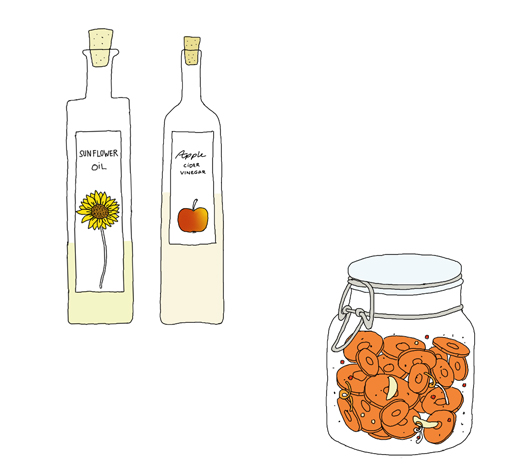
Pump up the carrots!
by Sofi Meijling
This time of year I am getting a bit bored with the old swedes, parsnips and carrots. Roasting them in the oven, blending them in a hot lentil soup, mashing them into a golden puree is all nice and comforting, but now’s the time to wake them from the dead of winter and let the sunshine in! This delicious way of enjoying them raw suits any blend of roots, or carrots on their own. They will keep for several days, so you can make a large batch at a time. (Just make sure to use clean tools when you fish out the portion needed.)
Orange Cured Carrots
Fill a glass storage container with thinly sliced carrots. I recommend the use of a mandolin, if you are not particularly fond of slicing.
Use one orange per pound of roots to make the marinade. Choose organic oranges, since you want to use the zest, but tart or sweet variety doesn’t matter, the acidity will have to be balanced to taste anyway. Grate the zest off first, then press the juice from the halved fruits. Add double the amount of sunflower oil, a pinch of salt, a pinch of sucanat, a pinch of Korean chili flakes, a little ground black pepper, and a clove of garlic, cut in half but not crushed. Now add your apple cider vinegar, generously if your brand is full-bodied, a little less if the oranges were tart to begin with; the mix should be fresh and pleasantly sour.
Pour the marinade over the carrots and leave in the fridge overnight. Try it as a side dish with pork, with roman lettuce and rocket in a green salad, gently heated with lots of blue poppy seeds for your vegetarian buffet – or as I did last week: add their glory to a fish soup.
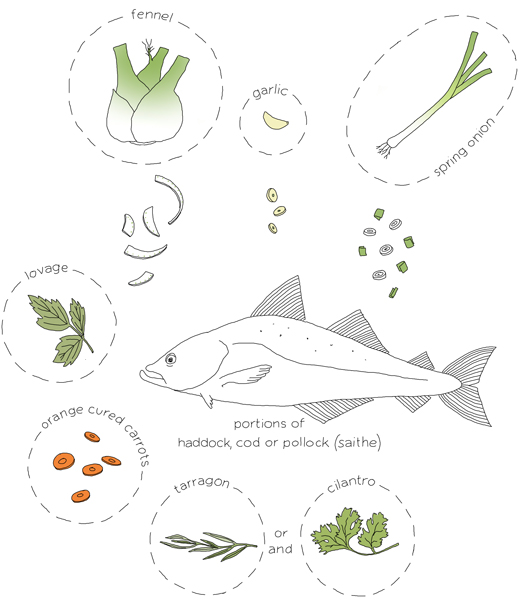
Waiting for spring Fish Soup
Sweat thinly sliced fennel, coarsely cut spring onion (or the green part of a leek) and a little thinly sliced garlic with olive oil. Season generously with salt, black pepper and some lovage. Set portion-cuts of haddock, pollock (saithe) or cod on top of the vegetables and add boiling water until just covered. Simmer gently for a few minutes. Add the oranged carrots when the fish is almost done, let them get warmed through but not softened. Sprinkle each serving with freshly chopped tarragon and/or cilantro.
(kokblog recommend to always check what fish to buy…
Seafood Watch (US) and WWFs fisk guide (Sweden)
*
related links